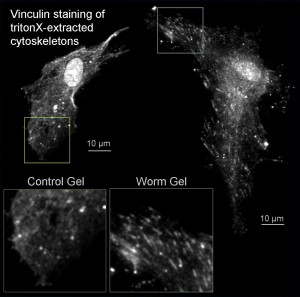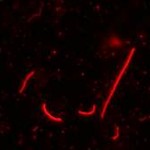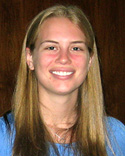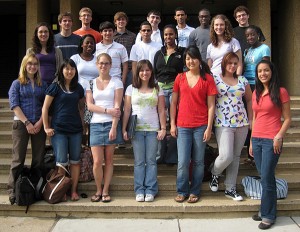Laura Wertz (University of the South), Christine Krieger (Penn), Karthikan Rajagopal (Penn) and Dennis Discher (Penn)

While these cells are on gels of the same stiffness, cells on worm gels have more pronounced focal adhesions and greater area, indicating that they feel a stiffer substrate.
The Problem:
Articular cartilage is comprised of collagen fibers in a sugar-water “ground substance.” In osteoarthritic cartilage, ground substance is degraded, making the tissue softer. However, cells may become more sensitive to the stiff collagen fibers despite overall softening.
The Experiment:
Culture MSCs on worm-free and worm-embedded PA hydrogels with the same bulk elasticity. Will cells react to the rigid polymer worms or only feel average stiffness?
The Results:
Cells on worm gels responded to the rigid worms, acting as if the substrate were stiffer than average elasticity measurements suggest. Even when average elasticity changes, cells on worm gels respond only to the worms.
 Worm gels are composed of, co-block polymer worms, 20-40 nm diameter, embedded in a polyacrylamide (PA) hydrogel. The worms mechanically mimic collagen fibers, and the PA holds water like the ground substance in articular cartilage.
Worm gels are composed of, co-block polymer worms, 20-40 nm diameter, embedded in a polyacrylamide (PA) hydrogel. The worms mechanically mimic collagen fibers, and the PA holds water like the ground substance in articular cartilage.
 Fundamental understanding of the mechanical environment at the cellular level will help us to predict how stem cells will behave when injected into tissue and to design substrates that will promote better cell/tissue differentiation in vitro.
Fundamental understanding of the mechanical environment at the cellular level will help us to predict how stem cells will behave when injected into tissue and to design substrates that will promote better cell/tissue differentiation in vitro.
This work was performed by Laura Wertz, a junior at the University of the South, Sewanee, while working with Prof. Dennis Discher, Chemical and Biomolecular Engineering, as part of the Penn-MRSEC REU program on materials. She was one of 24 undergraduates in a 10 week REU program which emphasizes outreach to under-represented groups that include women (50%) and minorities (38%) and which allows students to undertake individual research projects.

